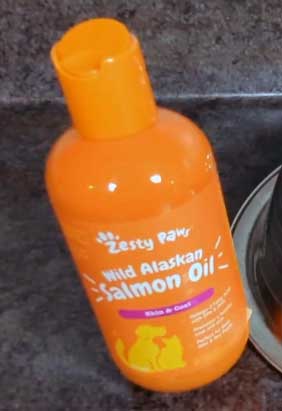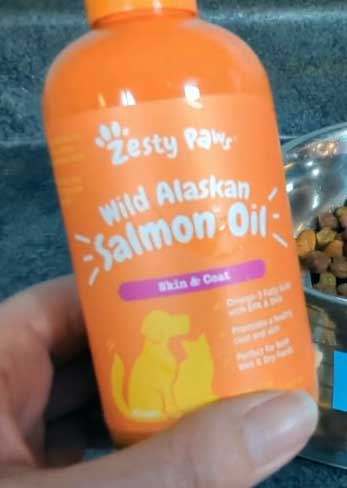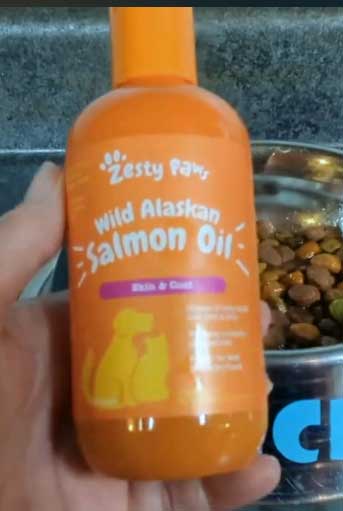If you’re a pet parent, you’ve probably seen Zesty Paws everywhere. Their bright packaging and promises of solving everything from itchy skin to dull coats are hard to miss. I was looking for something to help my dog’s dry, flaky skin, and the Zesty Paws “Wild Alaskan Salmon Oil” seemed like the perfect, natural solution. If you’re wondering if this popular supplement lives up to the hype and is the right choice for your furry friend, you need to read this. For pets with non-critical skin and coat issues, I think it’s a solid buy, but there’s a catch you need to know about first.
My Experience With Zesty Paws Salmon Oil

Let me walk you through my journey with Zesty Paws “Salmon Oil.”
My Golden Retriever, bless his heart, suffers from seasonal allergies that manifest as dry, flaky skin and relentless itching, especially during the spring and fall.
I’d tried everything – special shampoos, allergy chews – with limited success. Then I saw the Zesty Paws Wild Alaskan Salmon Oil.
The label promised support for skin and coat health, thanks to Omega-3 fatty acids EPA and DHA, sourced from pristine Alaskan waters.
It sounded perfect.
I ordered the 16oz bottle, which arrived with a convenient pump dispenser. The oil itself is a clear, golden liquid, and yes, it smells strongly of fish.
Not rancid, just… intensely fishy.
I followed the instructions, starting with half the recommended dose (based on my dog’s weight) pumped directly onto his kibble. To my relief, he didn’t hesitate. He dove right in, licking the bowl clean. Success on the palatability front!
Over the next few weeks, I gradually increased the dose to the full amount. Did I see a miracle overnight? No. But after about three weeks of consistent daily use, I started noticing subtle changes. His relentless scratching seemed to decrease. When I ran my hands through his fur, my palms weren’t covered in as much dander. His coat, which had been looking a bit dull, started to regain some of its natural golden sheen. By the six-week mark, the difference was undeniable. His coat was softer, visibly shinier, and the flaky skin was significantly reduced. He still had occasional itchy moments, but the frantic, non-stop scratching was gone.
Now, here comes the part where my experience gets a little more nuanced. While researching for this review, I discovered something crucial: the product label, despite the prominent “Wild Alaskan Salmon Oil” name, lists the ingredients as Pollock Oil, Salmon Oil, Mixed Tocopherols (a preservative). Pollock oil is listed first. This means it’s likely the primary ingredient, not salmon oil.
Pollock oil is still a good source of Omega-3s, but it’s generally less potent and cheaper than salmon oil. This felt a bit misleading, given the product name. While it did work for my dog, it wasn’t exactly the pure salmon oil I thought I was buying. This discovery definitely tempered my initial enthusiasm and made me look at the product, and the brand, a bit more critically. It’s effective, yes, but transparency matters.
Pros Of Zesty Paws Salmon Oil
- It Genuinely Improves Skin And Coat Health: Let’s start with the big one: it works. Despite my later discovery about the ingredients, the blend of Pollock and Salmon oil did make a noticeable difference for my dog. The Omega-3 fatty acids (EPA and DHA) in fish oil are scientifically proven to support skin hydration and reduce inflammation. In my dog’s case, this translated to significantly less scratching, fewer flakes, and a coat that went from dull and dry to soft and shiny. Many, many user reviews echo this experience. If your primary goal is to combat non-severe dry skin, dandruff, or a lackluster coat, this product is highly likely to deliver visible results within a few weeks.
- High Palatability For Most Pets: Getting a dog or cat to take a supplement can be a battle. The fact that this oil generally tastes good to pets is a massive advantage. The strong fishy smell, while potentially off-putting to us humans, seems to be a major draw for dogs and cats. My dog eagerly eats his food with the oil mixed in, and countless reviews confirm that even picky eaters often lap this stuff up. This makes consistency – which is key for seeing results – much easier to achieve. No hiding pills in cheese or forcing droppers into mouths. Just pump and serve.
- Includes Vitamin E (Mixed Tocopherols): The ingredient list includes “Mixed Tocopherols.” This isn’t just a preservative; it’s a natural form of Vitamin E. Vitamin E is a powerful antioxidant that works synergistically with Omega-3s. It helps protect the delicate fats in the oil from oxidation (going rancid) both in the bottle and in your pet’s body. Furthermore, Vitamin E itself contributes to skin health and immune function. Its inclusion adds a layer of quality and potential benefit beyond just the fish oil itself, helping to maintain the oil’s freshness and providing additional antioxidant support for your pet.
- Convenient Pump Dispenser (Usually): When it works, the pump dispenser is fantastic. It makes measuring out the correct dose quick, easy, and relatively mess-free compared to pouring liquid oil from a bottle. You just calculate the number of pumps needed based on your pet’s weight (usually 1 pump per ~10 lbs, but check the label) and squirt it directly onto their food. This convenience factor is a significant plus for daily use. (However, note the pump’s potential for leaks in the ‘Cons’ section).
- Made By A Reputable, Certified Company: Zesty Paws is not some fly-by-night operation. They were founded in 2014, are based in the US (Orlando, FL), and are now part of a larger global health group (H&H Group). They are a certified B Corp, meaning they meet high standards of social and environmental performance, accountability, and transparency. Crucially for pet supplements, they are also audited members of the National Animal Supplement Council (NASC), which signifies a commitment to quality control and stringent manufacturing standards. This provides a level of trust and assurance that you’re not getting a contaminated or poorly formulated product.
Read more: Comparison Of Bully Beds And Big Barker
Cons Of Zesty Paws Salmon Oil

Misleading Product Name And Ingredient Order
- It’s Primarily Pollock Oil, Not Salmon Oil: This is my biggest issue and feels deceptive. The product is boldly named “Wild Alaskan Salmon Oil.” However, the actual ingredient list reads: “Pollock Oil, Salmon Oil, Mixed Tocopherols.” Ingredients are listed by weight, meaning there is more Pollock oil than Salmon oil in the bottle. While Pollock oil is still a source of Omega-3s, it generally has a lower concentration of EPA and DHA compared to high-quality salmon oil, and it’s a cheaper ingredient. You are not buying pure, or even majority, salmon oil, despite the name suggesting otherwise. This lack of transparency is disappointing.
Potential For Digestive Upset
- “Fish Oil Runs” Are A Real Thing: Like any oil supplement, introducing Zesty Paws too quickly or giving too high a dose can cause digestive upset in some pets. The most common side effect reported is diarrhea or loose stools. This is usually temporary and can often be avoided by starting with a very small amount (half or even a quarter of the recommended dose) and slowly increasing it over a week or two, allowing your pet’s system to adjust. However, some sensitive pets may simply not tolerate fish oil well at any dose.
- Fishy Breath And Body Odor: It’s fish oil; it smells like fish. While pets often love the taste, that smell can sometimes translate into fishy breath or even a slightly fishy odor coming from your pet’s skin or coat. This isn’t harmful, but it’s something to be aware of if you’re particularly sensitive to smells or enjoy lots of close snuggles with your pet. The intensity varies between pets.
The Infamous Leaky Pump
- Prepare For Potential Mess: While the pump is convenient in theory, a significant number of user reviews (and my own slight experience) mention that the pump mechanism itself can leak. This can result in sticky, smelly fish oil residue around the bottle top, on your counter, or inside your storage cabinet. It’s not a universal problem, but it’s common enough that you should be prepared. Wiping the nozzle after each use and storing the bottle upright in a place where a small leak won’t cause damage (like on a paper towel inside a cupboard) is advisable.
- Inconsistent Pump Volume?: A less common but occasionally mentioned complaint is the potential inconsistency of the pump’s output. Does one pump always equal the exact same volume? It’s hard to verify without precise measurement, but if accurate dosing is critical (especially for very small pets), this potential variability is something to consider. Pouring might be more accurate if this is a major concern.
Maintenance Tips For Zesty Paws Salmon Oil
So you’ve decided to give Zesty Paws (Pollock &) Salmon Oil a try. Great! But fish oil is delicate stuff. If you don’t handle and store it correctly, it can go rancid, lose its potency, and even become harmful to your pet. Here’s how to keep it fresh and effective.
- Refrigerate After Opening – No Exceptions: This is the golden rule. The label clearly states “Refrigerate after opening.” Don’t just stick it in a cool cupboard; put it in the actual refrigerator. Omega-3 fatty acids are polyunsaturated fats, which means they are very susceptible to oxidation (going bad) when exposed to heat, light, and air. Refrigeration dramatically slows down this degradation process, keeping the oil fresh and preserving the beneficial EPA and DHA.
- Use It Or Lose It (Within 60-90 Days): Fish oil doesn’t last forever, especially once opened. The Zesty Paws label suggests using or discarding within 60 days of opening (though some general fish oil advice extends this to 90 days if refrigerated properly). Oxygen is the enemy. Every time you pump, a little air gets in. Even in the fridge, the oil will slowly start to oxidize. Buying the huge 32oz bottle might seem economical, but if you have a small dog or cat and can’t use it up within 2-3 months, you’re better off buying a smaller size to ensure freshness. Mark the date you open it on the bottle with a Sharpie!
- Do The “Sniff Test” Regularly: Your nose is your best tool for detecting rancidity. Fresh fish oil should smell fishy, but not overwhelmingly pungent or “off.” Rancid oil has a distinct, sharp, almost sour or acrid smell, very different from fresh fish. If you open the fridge and get hit with a smell that makes you recoil, trust your instinct. Don’t risk giving spoiled oil to your pet; discard the bottle. Rancid oil not only loses its benefits but can actually cause inflammation and digestive upset.
- Keep The Pump Nozzle Clean: Remember that leaky pump issue? Residue around the nozzle is prime territory for oxidation and attracting dust or bacteria. After each use, take a clean paper towel and wipe any excess oil off the tip of the pump nozzle before putting it back in the fridge. This minimizes mess and prevents that gross, sticky build-up that can also go rancid.
- Store Away From Light (Even In The Fridge): While refrigeration handles the heat aspect, light is also detrimental to Omega-3s. Most refrigerators have an interior light that comes on when you open the door. Ideally, store the bottle towards the back of the fridge, or even inside its original box if it came in one, to minimize light exposure. Every little bit helps preserve those delicate fatty acids.
Comparison With Other Brands

- Zesty Paws Vs. Grizzly Salmon Plus: This is a very popular competitor, often seen side-by-side with Zesty Paws. Grizzly Salmon Plus is also a blend, containing oils from wild Alaskan Salmon, Pollock, and Whitefish. The key difference lies in the potency and transparency. Grizzly clearly advertises it’s a blend and provides specific milligram amounts of EPA (approx. 598mg per teaspoon) and DHA (approx. 368mg per teaspoon) on their label. Zesty Paws uses percentages (9% EPA, 5% DHA per teaspoon), which requires calculation (approx. 405mg EPA, 225mg DHA per 4.5g teaspoon). So, Grizzly appears significantly more potent in EPA and DHA per serving. Both brands suffer from reports of leaky pumps, but Grizzly also seems to have a stronger, more polarizing fishy smell according to reviews. Grizzly is also NASC certified. If maximum Omega-3 potency is your goal, Grizzly seems to have the edge, but Zesty Paws might be more palatable for some pets.
- Zesty Paws Vs. Nordic Naturals Omega-3 Pet: Nordic Naturals takes a completely different approach. Their oil isn’t salmon or pollock; it’s sourced from wild anchovies and sardines. These smaller fish are lower on the food chain and generally considered to have lower levels of environmental contaminants like heavy metals. Nordic Naturals is renowned for its purity and third-party testing. They emphasize removing fishy taste and smell, making it an excellent choice for extremely picky pets who reject Zesty Paws or Grizzly. They also provide clear mg dosages per mL or teaspoon (approx. 690mg EPA and 414mg DHA per teaspoon for the standard liquid). The downside? Nordic Naturals is often significantly more expensive than Zesty Paws, and many users complain about the bottle design (no pump, messy pouring). You pay a premium for purity, lack of odor, and meticulous testing.
- Zesty Paws Vs. PetHonesty Wild Alaskan Salmon Oil: PetHonesty is another major player often compared to Zesty Paws. Their product also uses a blend of Salmon and Pollock oil (similar to Zesty Paws and Grizzly). They provide clear mg dosages on their label (often very similar to Zesty Paws). PetHonesty heavily markets being made in the USA with globally sourced ingredients and is also NASC certified. User reviews often mirror Zesty Paws: generally effective for skin/coat, good palatability, but occasional leaky pumps or digestive upset. Price-wise, they are usually very comparable. Choosing between Zesty Paws and PetHonesty often comes down to brand preference, current sales, or subtle differences in specific EPA/DHA numbers depending on the batch or exact product formulation. They are very direct competitors in the same market tier.
Read more: My Thoughts on Finn Probiotics for Dogs
Frequently Asked Questions (FAQ)
It’s decent quality, but the name is misleading. Zesty Paws is a legitimate US-based company (a certified B Corp and NASC member), which suggests good manufacturing practices. However, their “Wild Alaskan Salmon Oil” product lists Pollock Oil as the first ingredient, meaning it contains more pollock than salmon. While Pollock oil is still a source of Omega-3s, it’s generally cheaper and less potent than salmon oil. So, while it’s likely a safe and reasonably effective fish oil blend, it’s not the pure, premium salmon oil the name implies.
Yes, absolutely. High-quality fish oil, including salmon oil (or blends like Zesty Paws), is rich in Omega-3 fatty acids, specifically EPA and DHA. These have been scientifically shown to provide numerous benefits for dogs, including: improving skin hydration, reducing inflammation associated with allergies and itching, promoting a shiny and healthy coat, supporting joint health (especially in arthritic dogs), boosting immune function, and aiding cognitive development and function.
Yes, Zesty Paws Salmon Oil is formulated and marketed for both dogs and cats. Many cat owners report positive results, such as reduced shedding, improved coat shine, and relief from dry skin or dandruff. The Omega-3 fatty acids provide similar skin, coat, joint, and immune benefits for felines. However, cats can sometimes be pickier eaters than dogs, so palatability might be more of a challenge. It’s crucial to start with a very small dose for cats and ensure they tolerate it well digestively.
Conclusion
So, should you buy the Zesty Paws “Salmon” Oil? If you’re looking for a reasonably priced, generally palatable fish oil blend to improve your dog or cat’s coat shine and reduce mild dryness or itching, then yes, it’s worth considering. It works for many pets, comes from a reputable company, and the pump is convenient (when it doesn’t leak). However, if you are seeking the absolute highest potency Omega-3s, or if ingredient transparency is paramount and you specifically want pure salmon oil, you should look elsewhere. Know that you’re likely buying mostly Pollock oil, but if it works for your pet and fits your budget, it’s still a beneficial supplement.
